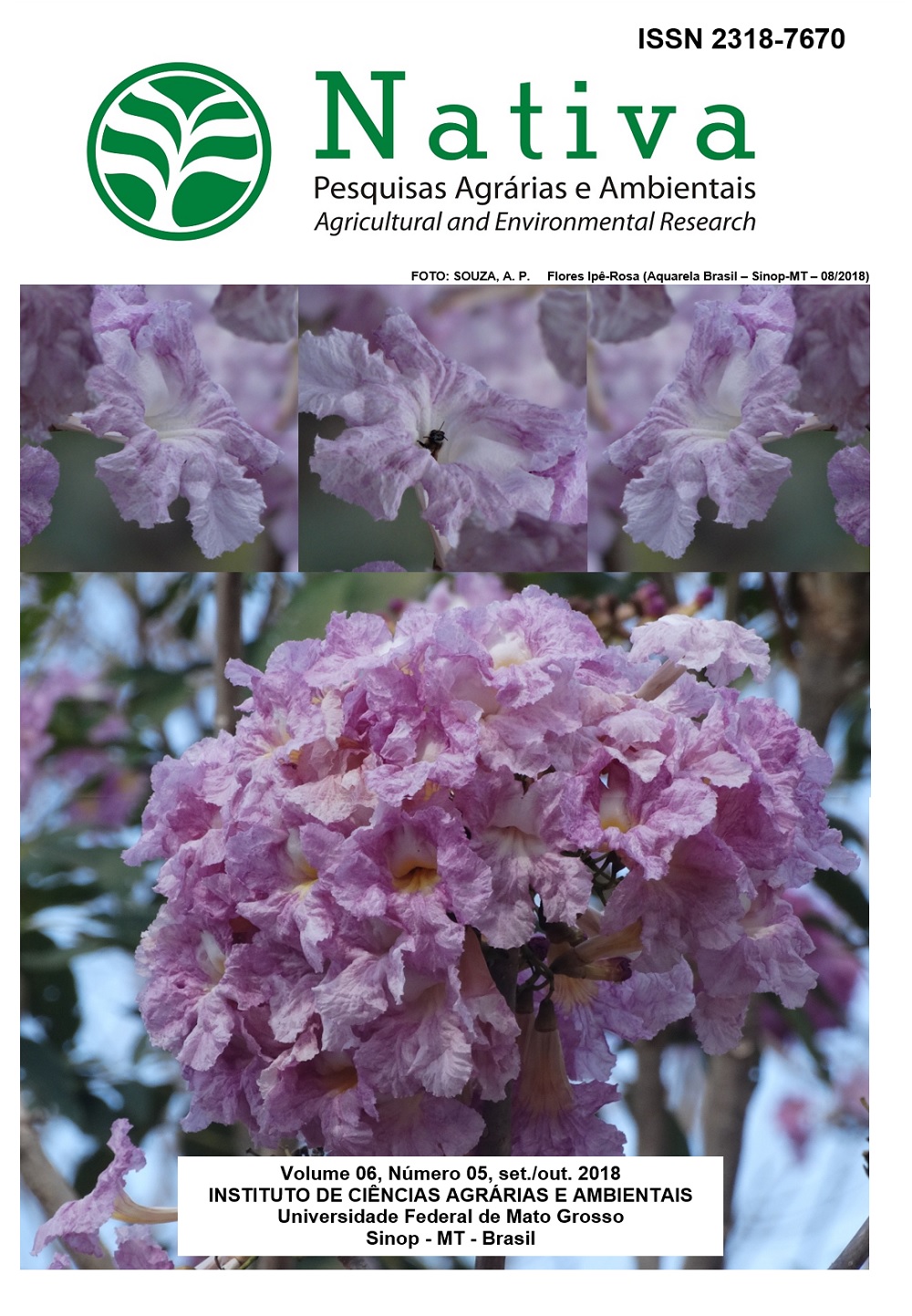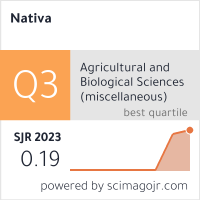ANÁLISE TEMPORAL DA OCORRÊNCIA DE INCÊNDIOS FLORESTAIS NAS AMÉRICAS E REGIÃO DO CARIBE
DOI:
https://doi.org/10.31413/nativa.v6i5.5845Resumo
Com as mudanças climáticas ocorridas nas últimas décadas e com longos períodos de estiagem, as chances de ocorrências de fogo com maior frequência e intensidade, aumentam e, sem o devido controle, acabam ocasionando grandes incêndios florestais. Como consequência, pode haver elevados prejuízos ao meio ambiente e à sociedade. Sabendo da importância das estatísticas sobre incêndios florestais, objetivou-se nesta pesquisa, analisar dados estatísticos publicados pela Food and Agriculture Organizacion of the United Nations – FAO, sobre as principais causas, ocorrências e áreas queimadas nas Américas do Norte, Central, Sul e Região do Caribe, no período de 1990 a 2004. Os dados foram tabulados de diferentes maneiras, a fim de produzir uma estatística única, de acordo com a série temporal proposta. Os países da América Central e Caribe são os que menos apresentaram dados disponíveis enquanto que, os Estados Unidos é o que apresenta maior base de dados estatísticos. Os resultados mostraram que a América do Sul tem as maiores médias, em comparação com as demais regiões, os Estados Unidos têm o maior quantitativo de ocorrências, existe forte influência de fenômenos como El Ninõ e que as atividades humanas foram responsáveis pela grande maioria das ocorrências de incêndios florestais.
Palavras-chave: proteção florestal, fogo, estiagem.
TEMPORAL ANALYSIS OF THE OCCURRENCE OF FOREST FIRES IN THE AMERICAS AND THE CARIBBEAN REGION
ABSTRACT:
With the climatic changes that occurred in the last decades and with long periods of drought, the chances of occurrences of fire with more frequency and intensity, increase and, without proper control, end up causing forest fires. As a consequence, there can be great damage to the environment and to society. The objective of this research was to analyze statistical data published by the Food and Agriculture Organization of the United Nations (FAO) on the main causes, occurrences and areas burned in North, Central, South and Central America of the Caribbean, from 1990 to 2004. Data were tabulated in different ways to produce a single statistic, according to the proposed time series. Central American and Caribbean countries are the least likely to have available data, while the United States has the largest statistical data base. The results showed that South America has the highest averages compared to the other regions, the United States has the highest number of occurrences, there is a strong influence of phenomena such as El Nino and that human activities were responsible for the great majority of forest fires.
Keywords: forest protection, fire, drought.
Referências
BARBOZA, R. I.; FEARNSIDE, P.M. Incêndios na Amazônia brasileira: estimativa da emissão de gases do efeito estufa pela queima de diferentes ecossistemas de Roraima na paisagem do evento “El Niño” (1997/98). Acta Amazônica, Manaus, v. 29, p. 513-534, 1999.
CANZIAN, W. P.; FIEDLER, N. C.; BRINATE, I. B.; JUVANHOL, R. S.; BIGHI, K. N. Diferentes concentrações de retardante de fogo em plantios de eucalipto. Nativa, Sinop, v.4, n.4, p.195-198, 2016. DOI: 10.14583/2318-7670.v04n04a02.
FOOD AND AGRICULTURE ORGANIZACION OF THE UNITED NATIONS (FAO). Global Forest Fire Assessment 1990-2000. Roma, 2001. 495 p.
______. Global Forest Resources Assessment 2005: Report on fires in the South American Region. Roma, 2006a. 42 p.
______. Global Forest Resources Assessment 2005: Report on fires in the Caribbean and Mesoamerican Regions. Roma, 2006b. 40 p.
______.Global Forest Resources Assessment 2005: Report on fires in the North American Region. Roma, 2006c. 37 p.
GLOBAL FIRE MONITORING CENTER (GFMC). Vegetation Fires and Global Change. Challenges for Concerted International Action. A White Paper directed to the United Nations and International Organizations. Germânia, 2013. Disponível em: < http://www.fire.uni-freiburg.de/latestnews/Vegetation-Fires-Global-Change-UN-White-Paper-GFMC-2013.pdf>. Acesso em: 08 set. 2017.
INTERNATIONAL ASSOCIATION OF FIRE AND RESCUE SERVICES (CTIF). Center of fire statistics. World fire statistics. nº 22, National committees CTIF of Russia, Germany, USA, 2017. Disponível em: < http://www.ctif.org/sites/default/files/ctif_report22_world_fire_statistics_2017.pdf>. Acesso em: 15 set. 2017.
INSTITUTO NACIONAL DE PESQUISAS ESPACIAIS (INPE). El Niño e La Niña. Disponível em:< http://enos.cptec.inpe.br/>. Acesso em: 15 set. 2017.
INTERNATIONAL FOREST FIRE NEWS COUNTRY NOTES (IFFN). Forest Fire Management in Canada. Disponível em: < http://www.fire.uni-freiburg.de/iffn/country/ca/ca_7.htm >. Acesso em: 12 set. 2017a.
______. Fire Situation in the United States. n. 27 – Jul. 2002, p. 6-13). Disponível em: < http://www.fire.uni-freiburg.de/iffn/country/us/us_17.htm>. Acesso em: 19 mai. 2017b.
______. Evaluación del Fuego en la Región de Latinoamérica: Mesoamérica, Caribe y América del Sur Conclusiones y Recomendaciones. Espanha, nº. 36, p. 6-9, Jan./Jul, 2007.
KELLY, L. T.; BROTONS, L. Using fire to promote biodiversity. Science, v. 355, p. 1264-1265, mar, 2017. DOI: 10.1126/science.aam7672
LIEROP, P. V.; LINDQUIST, E.; SATHYAPALA, S.; FRANCESCHINI, G. Global forest area disturbance from fire, insect pests, diseases and severe weather events. Forest Ecology and Management, v. 352, p. 78-88, 2015. DOI: http://dx.doi.org/10.1016/j.foreco.2015.06.010.
MACDICKEN, K, G. Global Forest Resources Assessment 2015: What, why and how? Forest Ecology and Management, v. 352, p. 3-8, 2015. DOI: http://dx.doi.org/10.1016/j.foreco.2015.02.006.
NUNES, A.; LOURENÇO, L.; LU, S. O.; FELIX, F. Vulnerabilidade a incêndios na Europa Mediterrânea. Abordagem conceptual e a utilização de dados de satélite. In: Atas das I Jornadas Lusófonas de Ciências e Tecnologias de Informação Geográfica. Sessão 5, Artigo 18, Coimbra, Portugal 2015. DOI: http://dx.doi.org/10.14195/978-989-26-0983-6_18.
PEREIRA, F. J., BATISTA, A. C., SOARES, R. Variação da umidade do material combustível florestal em função de índices de perigo de incêndios. Cerne, Lavras, v. 18, n. 3, p. 371-376, 2012.
RIBEIRO, M. I. M. Prevenção e detecção de incêndios florestais: Análise holística e sistemas tecnológicos. 2014. 140 f. Dissertação (Mestrado em Engenharia do ambiente). Universidade do Porto, Porto, 2014.
RODRÍGUEZ, M. P. R.; SOARES, R. V.; BATISTA, A. C.; TETTO, A. F.; BECERRA, L. W. M. Comparação entre o perfil dos incêndios florestais de monte alegre, Brasil, e de pinar Del Rio, Cuba. Floresta, Curitiba, v. 43, n. 2, p. 231 - 240, 2013. DOI: http://dx.doi.org/10.5380/rf.v43i2.
SCHINDLER, L.; FLACHSENBERG, H.; ROMERO, F. Incendios Forestales en Guatemala, Honduras y Nicaragua - Análisis de la situación presente y acciones a seguir. GTZ, Germany, 2002.
SOARES, R. V. Perfil dos incêndios florestais no Brasil, de 1984 a 1987. Floresta, Curitiba, v. 32, n. 2, p. 219-232, 1988.
SOARES, R. V.; BATISTA, A. C.; NUNES, J. R. S. Incêndios florestais no Brasil: o estado da arte. Curitiba: 2009. 246p.
TETO, A. F.; BATISTA, A. C.; NUNES, J. R. S.; SOARES, R. V. Subsídios à prevenção e combate a incêndios florestais com base no comportamento da precipitação pluviométrica na floresta nacional de Irati, Paraná. Ciência Florestal, Santa Maria, v. 20, n. 1, p. 33-43, 2010.
TORRES, F. T. P.; LIMA, G. S. L.; MARTINS, S. V.; VALVERDE, R. V. Analysis of efficiency of fire danger indices in forest fire Prediction. Revista Árvore, Viçosa, v. 41, n. 2, p. 1-10, 2017. DOI: http://dx.doi.org/10.1590/180690882017000200009.
Downloads
Publicado
Edição
Seção
Como Citar
Licença
Direitos Autorais para artigos publicados nesta revista são do autor, com direitos de primeira publicação para a revista. Em virtude de a aparecerem nesta revista de acesso público, os artigos são de uso gratuito, com atribuições próprias, em aplicações educacionais e não-comerciais.
A artigos publicados nessa revista, podem ser reproduzidos parcialmente ou utilizados como referência por outros autores, desde que seja cita a fonte, ou seja, a Revista Nativa.
Copyright for articles published in this journal are the authors, with first publication rights granted to the journal. The journal shows open access, and articles are free to use, with proper attribution, in educational and non-commercial.
The articles published in this journal may be reproduced in part or used as a reference by other authors, provided that the source is quoted.






